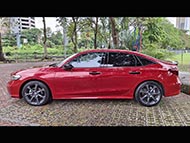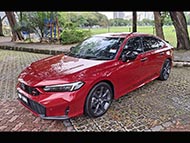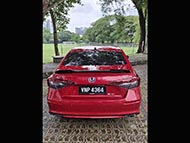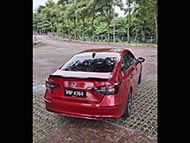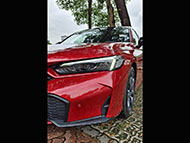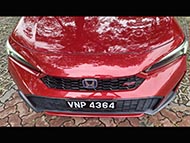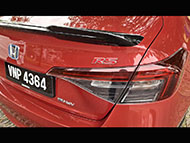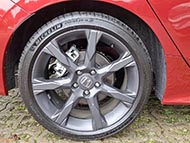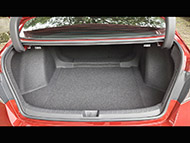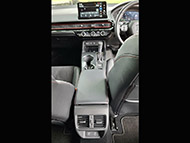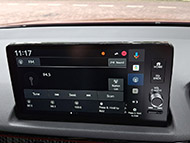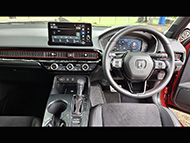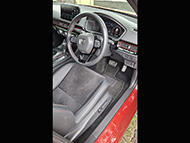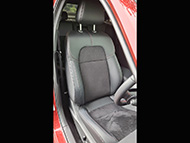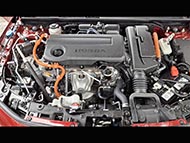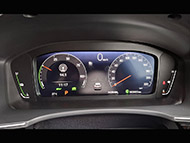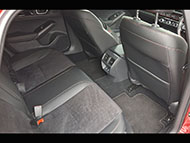By Lee Pang Seng
HYBRID motoring is the best alternative to EV (electric vehicle) ownership as it does away with range anxiety and provides even higher mileage than normal ICE (internal combustion engine) vehicles. Hybrid technology comes in two primary forms; mild hybrid and plug-in hybrid.
The former comes equipped with a small battery that provide EV mileage of 50km or less. The plug-in hybrid has a bigger battery that usually provides EV mileage above 50km and some, even above 100km. It comes with a charge point and you need to charge the battery regularly to maintain it in optimal condition.
Carmakers are also approaching hybrid motoring in their respective way. Honda, for one, has its e:HEV system or enhanced Hybrid Electric Vehicle. This system was first introduced in the City in 2020 and the Civic was equipped with the system in 2022. The mild hybrid system was continued with the latest Civic generation that was launched in January this year.
The new Civic is duly updated with the e:HEV RS, which holds flagship status, featuring body-coloured front grille extensions, lower grille garnishes and 18-inch Matte Grey alloy wheels. The rear sees a sleek black taillamp extension to enhance its modern design and the RS models get a new RS emblem.
Our acquaintance with the Honda e:HEV system has so far been on long distance drives with different models, including the 2023 drive to Desaru, Johor with the first Civic e:HEV model. Economy runs for some of the drive events drove home the fact that you could enjoy mileage of above 20km/l with normal driving (that means gentle and progressive accelerator use).
City driving was pretty limited in all those events and when the opportunity to gain some urban insight into the Honda e:HEV driving came along, we jumped at it. Like a BEV (battery electric vehicle), a hybrid vehicle is at its fuel-saving best in urban driving because of the electric power coming into play often.
Before we share our experience with the latest Civic e:HEV RS, here’s a refresher on what the Honda e:HEV is all about. The Civic comes with a 2.0-litre Atkinson Cycle direct injection engine with a modest power output of 105kW (143PS) at 6000rpm and 189Nm at 4500rpm. The role of this efficiently operating engine is mostly to charge the battery and be engaged to drive the Civic at cruising speeds on the highway.
Powering the front-wheel drive Civic e:HEV in urban traffic is an electric motor rated at 135kW (184PS) at 5000-6000rpm and lots of torque at 315Nm from 0-2000rpm. Feeding the motor with electric power constantly is the ‘power-dense’ 1kW lithium-ion battery located under the rear seats. In that way, the Honda e:HEV is almost as good as any EV because it is running mostly on electric power in urban centres.
Contributing to the operating efficiency and energy management of the e:HEV system is the Power Control Unit (PCU) in the engine compartment that enables faster charge and discharge of electricity. Its higher power density increases electrical output via aluminium core high-voltage wires for the car to run on clean energy.
The transmission is an e-CVT or electric Continuously Variable Transmission. The electric part comes in when it offers seamless engagement by the respective power source on the move. In performance, the Civic e:HEV is faster from 0-100km/h than its ICE variants as the strong electric torque gives it good initial boost to cover the run in 7.9 seconds (8.3-8.5 seconds for the ICE models). Top speed is understandably lower at 180km/h (200km/h). It also scores in average fuel consumption at 4.0L/100km (25km/l) against 6.0-6.3L/100km.
Being the flagship model, the Civic e:HEV RS comes with a few extras such as the key card, Individual Mode for the Drive Mode Selector (the standard modes being Econ, Normal and Sport), Deceleration Selector Pedal (for the battery regeneration mode), Dual Auto air-conditioning system, among others.
The key card is provided in addition to the keyfob and you could carry either with you. We feel the key card is more convenient as it could be easily carried in the wallet. You could open and unlock the doors with either, and the walk away auto lock that is common to the Civic range worked just fine with the key card.
For a mild hybrid car, the Civic is pretty low in height, which might not go too well with those with back aches. It is as low as our Mercedes-Benz C200 (W204) with a vehicle height of 1415mm. With black sporty wheels equipped with Michelin Pilot Sport 235/40 R18 tyres, it has all the trappings of youthful vigour in looks that endear the Civic to the younger set.
Despite its low-slung profile, we were surprised that it has a better ground clearance than our Merc. The truth of the pudding was when it came to speedbumps; most times, we had to drive over them slowly with the Merc but not so, with the Civic. It cleared all and sundry the many speedbumps that we drive over daily, even with a full load. It also took to the bumps and potholes without a jarring effect, impressing us on its ride comfort in spite of the low profile tyres.
Based on past experiences driving the Civic, on long distance runs and at the Sepang International Circuit, the Civic e:HEV RS was right at home being driven at good speeds through our favourite corners and sweeping curves. The MacPherson strut front and multi-link rear suspension was well tuned for comfort and handling performance.
We also enjoyed the brisk take-up in initial acceleration as well as passing moves, what with lots of strong torque coming in early from the electric motor. And on hard acceleration, the Active Noise Control with Active Sound Control provided an engine note as if it was being revved up. That added to the thrill of picking up speed quickly.
With the 10.2-inch TFT instrument panel (the biggest among the Civic variants), we took pleasure in gleaning all the information that we want at a glance; the battery level and the way it was charged up, the electric power being deployed, the radio station that we were currently tuned to, road speed via the speedometer and digital readouts, and even the time.
On take-offs in the urban scenario, the Civic e:HEV was mostly on EV mode as indicated on the instrument panel. Each time we hit the brakes or decelerate, we could see the rate of battery regeneration. Likewise, the battery being charged by the engine as we hit the highway. That the Civic e:HEV was sipping fuel was clear when we returned the car with the fuel level still above the quarter level.
A likeable feature was the turn indicator function; when we want to change lanes or turn to the left, a camera on the door mirror picks up the traffic and road images. These are displayed on the nine-inch central touchscreen, giving us a good idea of the traffic or the road when turning left, especially in tight areas.
Another neat feature was the use of different colour guides for reversing; if the angle of entry into a parking space was off, the colour guide is in orange. If it turns yellow, then we know the angle of entry was about right. Little things such as these made driving the Civic e:HEV RS an enjoyable one.
Being the flagship model in the Civic range, the Civic e:HEV RS naturally carries a premium price. At RM167,900 on the road, it is RM18,000 more than the Civic Petrol RS with 1.5-litre VTEC Turbo. If you wish to enjoy better fuel consumption in the urban environment, the Civic e:HEV RS is undeniably the better choice
